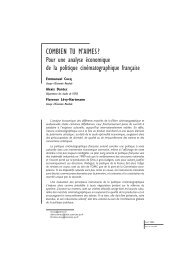N° 2005-09 Juin 2005 Guillaume Daudin* Jean-Luc Gaffard ...
N° 2005-09 Juin 2005 Guillaume Daudin* Jean-Luc Gaffard ...
N° 2005-09 Juin 2005 Guillaume Daudin* Jean-Luc Gaffard ...
You also want an ePaper? Increase the reach of your titles
YUMPU automatically turns print PDFs into web optimized ePapers that Google loves.
Georges Pujalsthe number of electronic cash transactions is still growing. The IT-driven transformation ofbanks has not yet come to an end. Financial services firms give priority to their ITorganisation’s potential to reduce the company’s overall operating costs and improve theproductivity of the workforce.Chart 4. Relative IT spending in different industry (% of revenue)76543210Financial servicesindustryHealth careTransportManufacturingFood industryChemical industryUtilitiesTradeSource: Deutsche Bank Research (2004).Recently, we also have seen a growth of outsourcing in more strategic areas such ashuman resources, accounting/finance and “business processing outsourcing” (BPO), i.e.outsourcing of a business line or process in its entirety. BPOs also mean that the relationshipbetween the outsourcer and the third party changes somewhat as the latter becomes more astrategic partner than a traditional supplier. Such growth could be seen as part of a trend awayfrom outsourcing of specific tasks towards more strategic operations.2.2. OffshoringWhile offshoring is a trend across all sectors, the financial services industry in particularis keen to relocate processes and job to low-cost destinations (see Chart 5) and it can achievethe greatest savings from offshoring operations. Since insurers first and banks secondtypically have a plethora of IT-based processes and corresponding costs, they harbour thebiggest cost-savings potential to be tapped via offshoring. Banks can save 8-12% of theiroverall costs, and insurers as much as 10-15%.35








